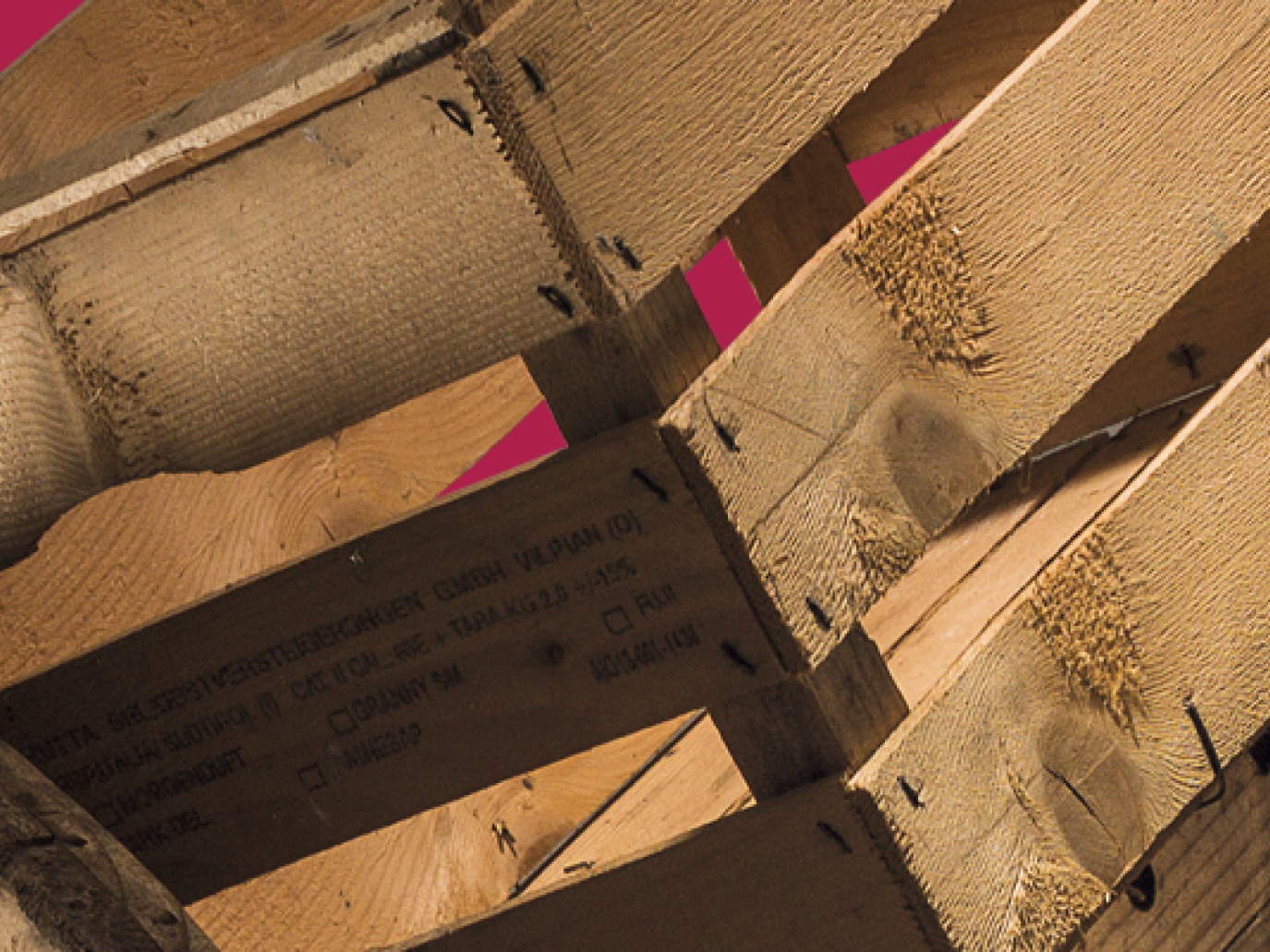The Rilegno consortium has been gathering, recovering and recycling wood from wood packaging in Italy for more than 20 years. Consortium and independent bodies have gathered and recycled around 1.8 million tons of wood in 2017, with a 10% volume increase compared to the prior year.
Before we go in depth on the value of wood and the activities carried out by the Consortium, we must remind you that preventing, recovering, reusing and recycling are the guidelines that Rilegno follows on a daily basis in its approach to sustainability and circular economy.
Recycling
Wood is a precious natural material with an endless life cycle, and has always accompanied mankind’s activities. After its first use, wood is collected and recycled in order to be transformed into a new product thanks to Rilegno’s effort, but most of all thanks to citizens, municipalities and companies.
Raw particle boards are the main product of recycling; this product gave birth to an industry that did not exist 20 years ago. Today, the furniture industry uses 85% recycled raw particle boards, enabling Italy to procure material that would otherwise have to be bought from foreign countries.
The efficient management of wood recycling is an economic resource as well as an effort towards a more sustainable world, giving life to a true circular economy which is very important for Italy.
Other forms of recycling in addition to the particle board are: wood-cement blocks for buildings, small blocks for pallets, chemomecanical paste for the paper industry and compost. Only a residual part is destined to energy production.
Rilegno’s numbers
How is recycling process reached? In order to summarise the circular economy of wood, we can state that there are 2,367 Rilegno consortium members, 4,400 municipalities participating in agreements with Rilegno, 400 recovery platforms spread on the territory in service of the industrial and commercial fabric and 13 recycling plants. These are the main actors of the circular economy of wood, with the addition of Italian citizens and companies. This industry generates a 2.8 billion euro turnover and involves 30,000 employees.
Most of the 1.8 billion tons of recovered and recycled wood in Italy are made up of wood packaging – pallets, fruit and vegetable baskets, cases, cages, cable reels – more than 60% of wood released for consumption is recycled, around two out of three kilograms o wood on the market (with a 3.19% growth compared to 2016).
Furthermore, nearly 725,000 tons of pallets (the equivalent of 50 million units) are not collected and recycled, instead, they are reused in the industrial logistic circuit following the logic of reuse and prevention.
Thanks to the agreement subscribed with ANCI (Associazione Nazionale dei Comuni Italiani, National Association of Italian Municipalities), Rilegno has stipulated agreements with more than 4,400 municipalities, serving more than 41 million inhabitants (approximately two thirds of the Italian population): in fact, 592,000 tons of wood are collected thanks to separate waste collection.
On the issue of Italy’s role in the circular economy of wood on an international and European level we can state that Italy has more than doubled the recycling objectives set by the European Union in 2017. The new directives state that the amount of recycled wood packaging must reach 30% by 2030, Italy has already reached 61%.
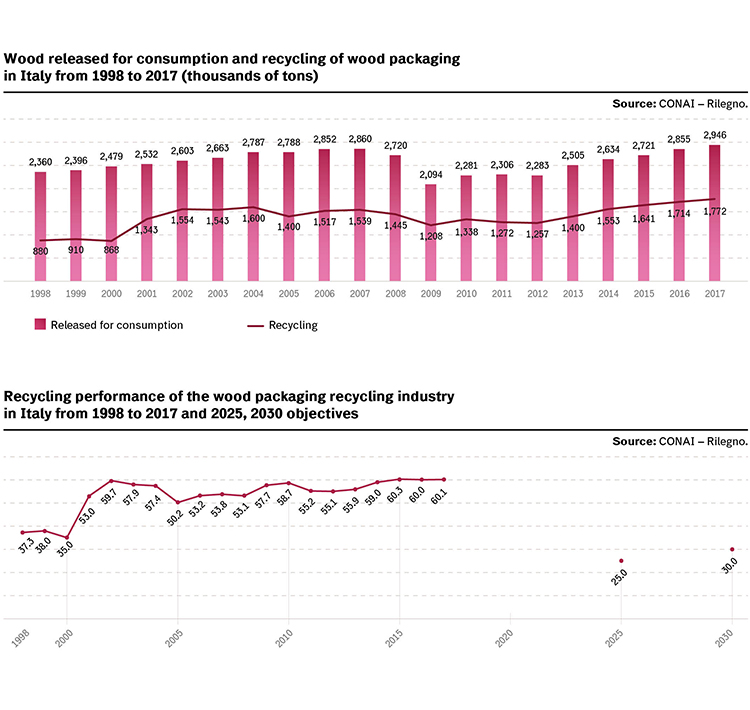
The future
With regards to the future, the real challenge is for us to be the main force behind change, and this is must be done in a digital, traceable and smart manner, in an era where data governs business processes. Our project is to create wood packaging that is not just a container, but is able to provide data on its content.
Rilegno has started a few project, studies and researches in 2017:
- The MOCA project – Materials and Objects in Contact with wood foodstuffs with the University of Genova;
- Triennial Observatory, in collaboration with the Politecnico di Milano, in order to identify possible innovative applications of wood recycling;
- The traceability and management project of affiliate wood waste, providing the industry with a web portal and an IT portal used to share and trace information on logistics, which currently involves every region of Central-Southern Italy;
- The path towards the implementation of a supply chain assessment, based on an application of Network & Flow Modelling, that will enable to evaluate atmospheric emission of various ecological indicators (CO2, PM10, NOX, SO2). The final objective is to estimate the optimal opportunity to start recycling in terms of number of journeys, costs and environmental impacts;
- Designing a CRM (Customer Relationship Management), an application used to manage and optimize relationships with Consortium stakeholders and pertaining data. The system will be supported by a Business Intelligence system;
- An investigation on the aspects connected to the current legislation in terms of energy recovery and recycling of wood waste on a European level, as well as the sectors where these materials are used;
- The renovation of the Integrated Management System for Quality and Environment based on the ISO 9001:2015 and ISO 14001:2015 norms. The activities connected to the “Recycling Objective” project involving CONAI, Rilegno and the DNVGL certifying body are continued;
- 20 years after its birth, Rilegno decided to deeply reconsider its communication policy and its positioning. The renovation of the logo and the new institutional model are some of the actions taken by the consortium, in addition to a new advertising campaign, a new website and consequent digital repositioning, a renewed press office activity with a stronger media presence and the participation to numerous events and award ceremonies, in order to grow on a national scale, but always keeping an eye on the local dimension.
In conclusion, 2017 was an overall positive year for the Consortium, that consolidates itself as a solid national reality as well as its excellence on a European level. Our future objective is to act in respect of the parameters established by law, using technology to promote sustainability. We have reached important targets this year, and we will reinforce them in the future with the support of an ever increasing awareness of the importance of circular economy. A future where sustainability will be the norm is what we work for every day. Transforming potential waste into a valuable element is not a utopia, we believe that the Consortium may still be the provider of services that will give value to associated companies, citizens and the territory.
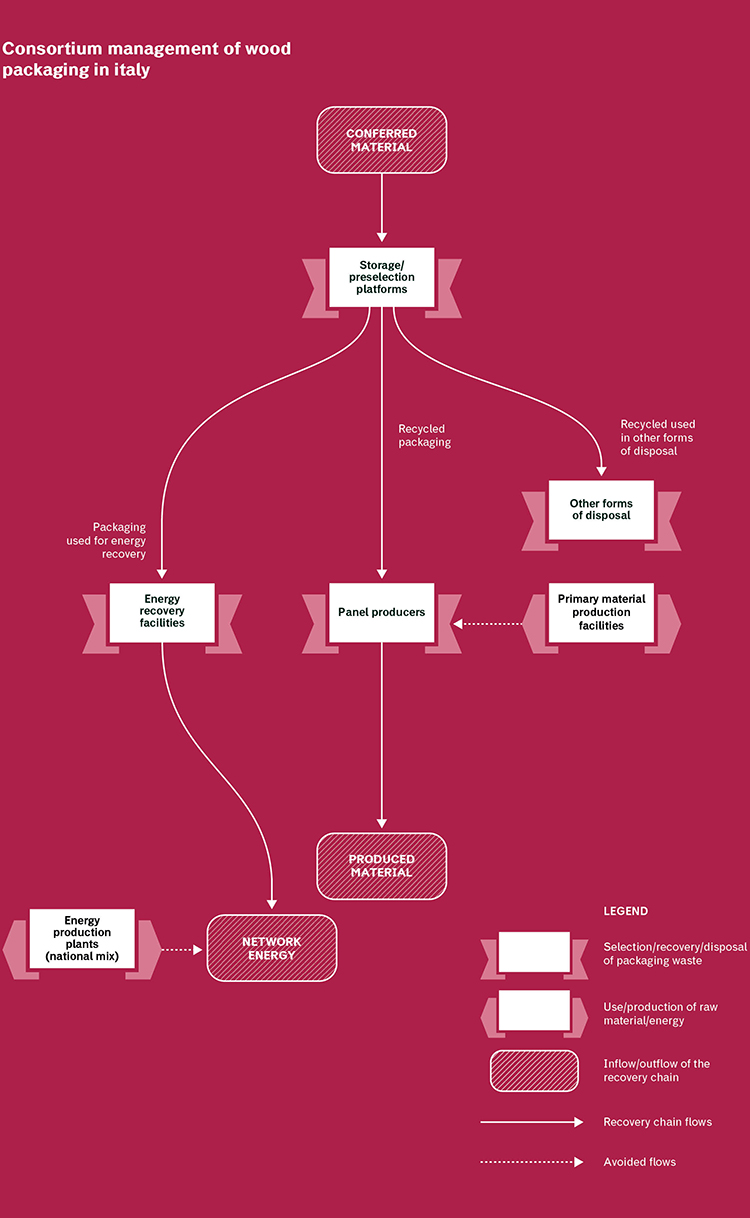
Environmental and socio-economic benefits of consortium management
The Rilegno Consortium recycled 848,000 tons of packaging in 2017, equal to 48% of the total wood recycled in Italy in the same year. The quantities handled by the Consortium show an uneven trend, with a good progression in the last four years, characterised by a regular growth that is bringing figures back to their pre-crisis state, and improving after the lowest recycling quantities registered in 2013.
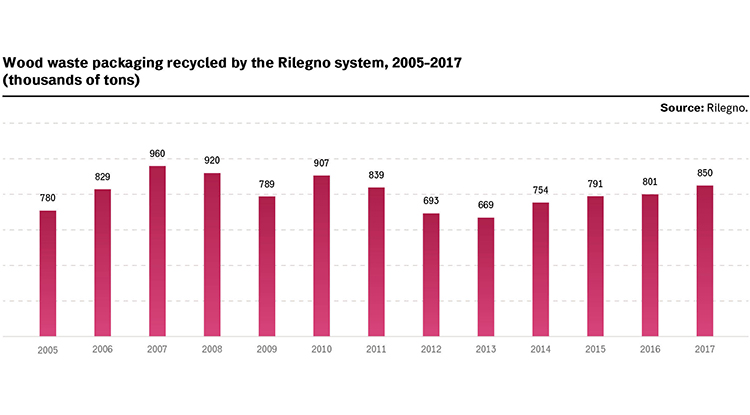
CONAI LLC Tool results show that the wood packaging recycling carried out by Rilegno between 2005 and 2017 prevented the use of 10.5 million tons of raw material in Italy, the equivalent of 483 million pallets.
The trends connected to saved raw materials thanks to recycling are correlated to the development of recycled material, showing an uneven trend. Thanks to the recycling of wood packaging, the activities carried out by the Rilegno Consortium prevented the use of 848,000 tons of raw material in 2017, 6% more than 2016, in line with the increase of conferred and recycled waste.
The activity carried out by the Consortium connected the consumption of primary energy between 2005 and 2017 allowed our country to avoid the use of 6 TWh, the equivalent of the primary energy consumed by three medium sized thermoelectric power plants. The data regarding matter recovered from recycling, primary material saved and primary energy saved show analogous trends.
The energy savings derived from the recycling of wood packaging managed by Rilegno in 2017 was equal to 0,41 Twh of primary energy from fossil fuels, an improvement in comparison to 2016.
The activities carried out by Rilegno between 2005 and 2017 avoided the emission of 498 million tons of CO2eq, equal to the emissions generated by 152,000 cars with an average travelled distance of 20,000 kilometres over the course of one year. Rilegno’s recycling activities prevented the emission of 58,000 tons of CO2eq in 2017. We must specify that the 2005-2009 period shows a negative value for avoided CO2 production from recycling. This was caused by pre-treatment/separation operations and the transport of materials that were higher than the avoided impacts connected to production and transport of raw material. The Global W Performance indictor is computed as a net balance of avoided and produced emissions produced by recycling preparations. Therefore, its development varies according to recycled quantities and emissions produced by the activities that take place before recycling.
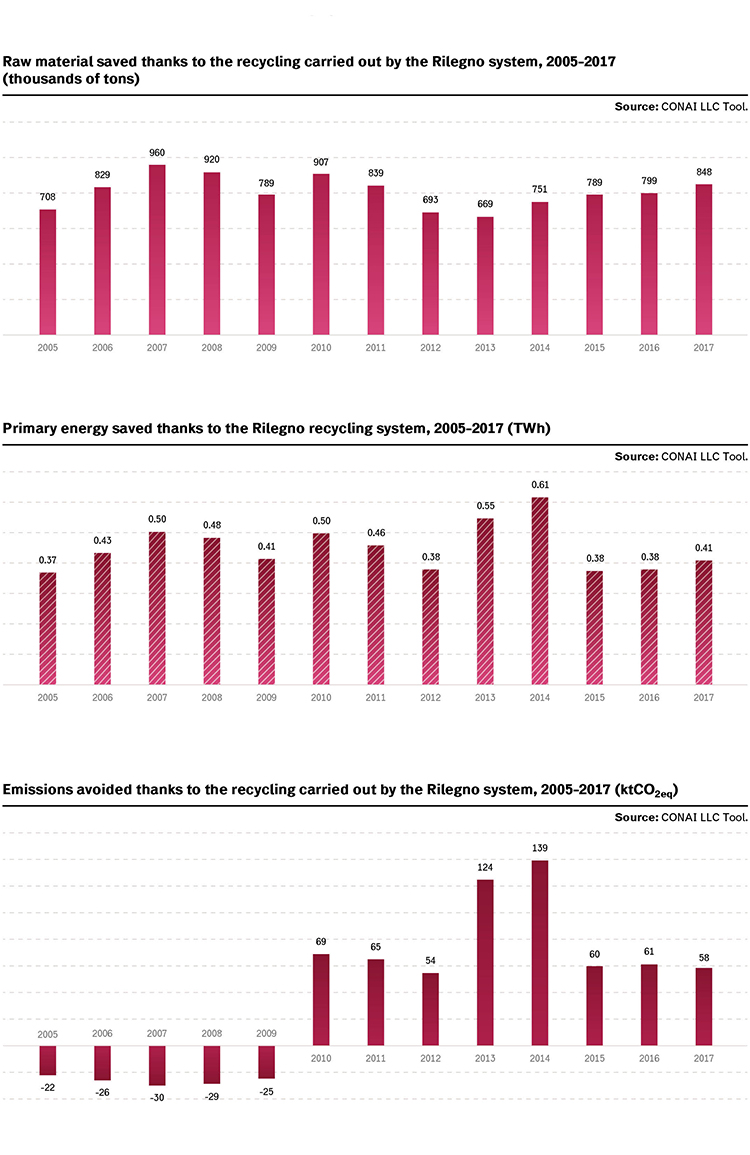
The economic benefits generated directly and indirectly for the country-system estimated by application of the LLC Tool on the environmental benefits we just spoke of amount to 10 million euros in 2017. The reduction of economic benefits caused by recovered material during the course of the years is bound to the decrease in the economic unit value of the material, that went from 30 euros/t to 10 euros/t in the period from 2005 to 2017 (these figures derive from speculations made directly by the consortium).
On the whole, the consortium wood waste packaging recovery industry has generated a 250 million euro economic value made up of:
- 237 million euros of direct benefits generated by the consortium wood waste packaging recovery industry, represented by the economic value of saved raw material;
- 13 million euros of indirect benefits referring to the CO2eq emission prevented by the recycling activities carried out by consortium management; the total for 2017 is 2 million euros (twice the estimated amount for 2005).
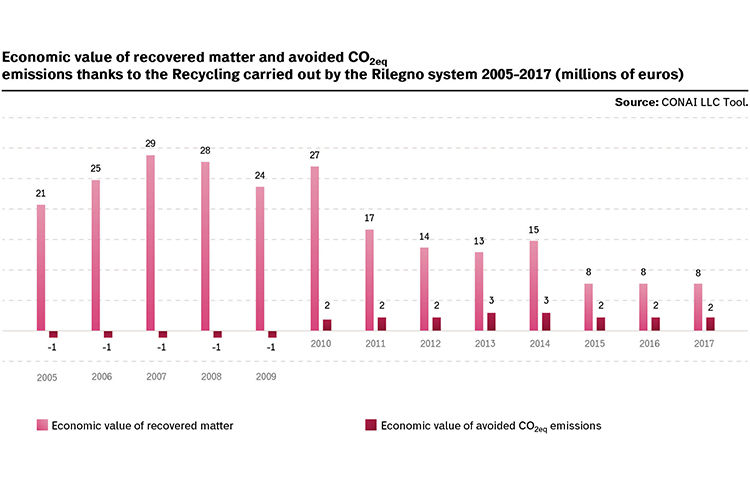
Top Image – Credit: Rilegno


